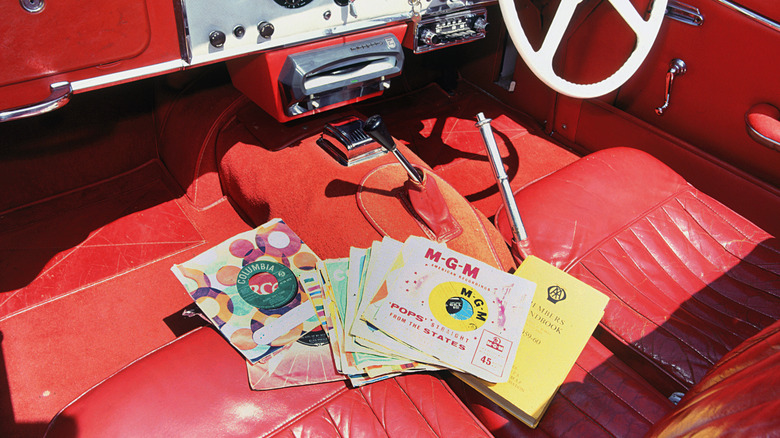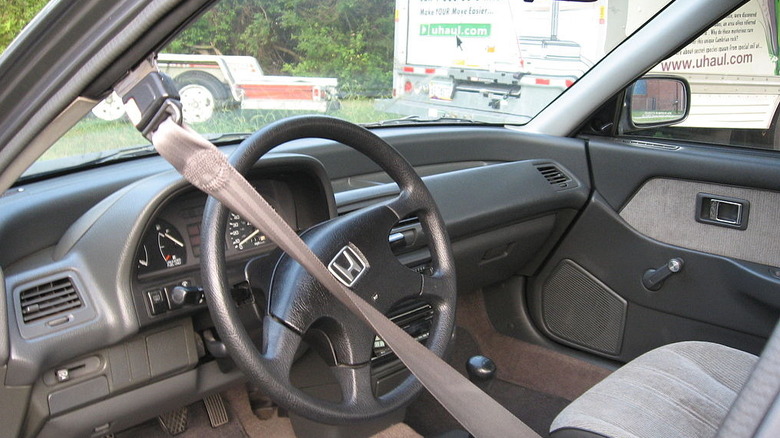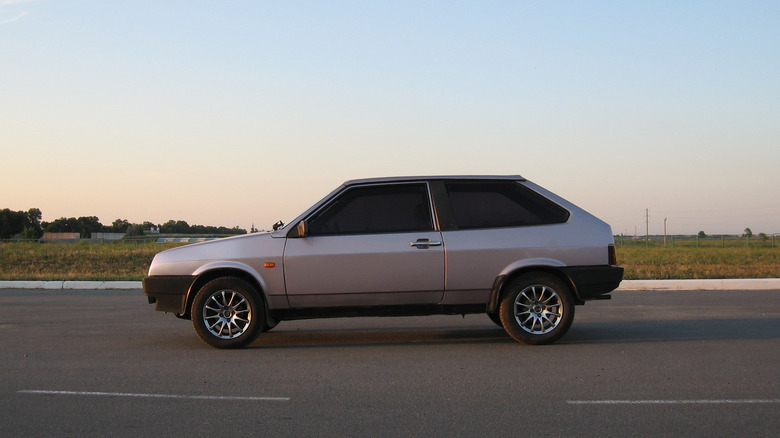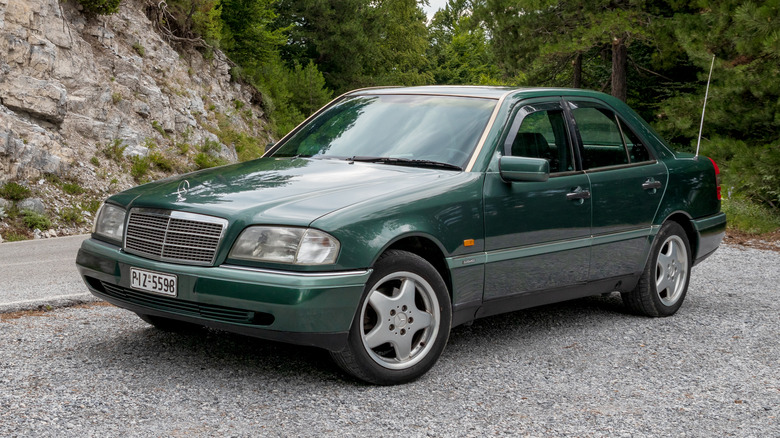Car Features That Were A Horrible Mistake
For as long as there have been cars, manufacturers have been packing them with as many features as possible. These often make our lives easier by making the car more comfortable or more practical while some features make it more efficient and affordable to operate. Features can be necessary systems that are required for full function or they can be superfluous additions that exist just to make life easier. Often, they just look cool — and may not even have a productive purpose.
We have seen some brilliant additions to the automobile like satellite navigation, remote start, and even fuel injection. These make the cars objectively better. Still, sometimes engineers and designers get things wrong. Sometimes the government mandates things that maybe should have been left alone. When a feature goes awry, it usually creates bad press that gets even worse in the rumor mill. Here we have a list of some auto features that proved to be horrible mistakes.
Record Player
Sometime in the 1930s, someone got the idea to add a radio to the automobile and called it a Motorola. The idea took off, and now having a car without a radio seems completely foreign to modern sensibilities. The radio soon became among the most popular option available for cars with it being standard on higher trim and luxury vehicles.
While it is immediately apparent why the radio is such a good feature to include in an automobile, it should be immediately apparent why a record player is not a good feature. However, just because a thing does not appear to be a good idea does not mean humans will not at least attempt to make it happen. Hemmings detailed the existence of this novel contraption and its shortcomings. Chief among them is that, although the prototype was fine-tuned for the test car, the player skipped dramatically when installed on production cars and led to mass complaints. Furthermore, in order to offer music that would not require flipping a record every two and a half minutes and traveling with a stack of discs to swap continuously, a new format was devised so that the player only worked with records made specifically to play on it.
It was a product that succumbed to its inventiveness without first asking if anybody would want it. Chrysler was the only manufacturer to offer it and it was a short-lived experiment for good reason.
Automatic seatbelts
From the 1950s until today, automakers have put much effort into making cars safer. We reported that Nash first offered a seat belt as an option and Volvo first made them standard. Technology in safety advanced significantly from the 1950s to the 1980s, and laws requiring the use of seatbelts reduced traffic fatalities in this time period. Sometimes, automakers introduce a feature to enhance safety with convenience. Automatic seatbelts are one such idea.
In many cars of the early 1990s, shoulder belts were attached to a buckle that moved along the door frame on a track and automatically secured the occupant upon closing the door. In some models, it was simply attached permanently to the door and the act of opening the door itself allowed you to enter the vehicle. This left the lap belt to be fastened manually. Everyone who rode in one of these cars hated these seatbelts. Jalopnik says that this feature existed to appease NHTSA regulators and avoid installing more expensive airbags in their cars. Because they were so annoying, many people simply unhooked them or never bothered to fasten the lap belt, making the ride potentially more dangerous.
Talking cars
When the digital age hit in the early 1980s, technologies taking advantage of the microprocessor sprouted up across nearly every industry. For automakers, it set the stage for much better engine management systems and lead us to the hyper-efficient cars we have today. But, for a time, the manufacturers also used this technology to try and add convenience and utility to our cars in novel ways. One of them was the talking car.
Several manufacturers, including Nissan and Chrylser, embraced this tech and added it as an option. This meant that whenever you enter your car, you are greeted with audible messages of the same voice as a Speak and Spell alerting you of things such as, "the door is ajar" or "your engine oil pressure is critical, engine damage may occur." Sometimes these messages would repeat until canceled by pressing a button or closing a door. This tech was accomplished, according to Hagerty, but utilizing the same tech that powered the Texas Instruments Speak and Spell with a 2-kilobyte ROM ship at first while moving up to a 16-kilobyte chip by the late '80s with a wider range of vocal warnings. Cars were offered this option from about 1983 to 1989 and, except for reasons of nostalgia, nobody misses it.
iDrive
Including the BMW iDrive system on this list is, admittedly, a bit controversial. The focus here is on the earliest versions of it, as it has been updated and upgraded continually for around two decades. BMW has a fervent fan base that will stand by just about anything they make, including early iDrive, but detractors can be found. According to the manufacturer, the first BMW with iDrive was the 2001 7 series.
Early iDrives consisted of a screen in the center of the dashboard and were operated with a rotary dial and a couple of variable function buttons. The biggest complaints come from the complexity of the system and the lag. It features extraneous menus that must be navigated to accomplish functions previously handled by a button. This did give the designers the ability to clean up the interior and offer a less cluttered cabin. It would be tough to say it is a universally panned feature. Motor Trend acknowledged early adopters finding it a bit complicated and that it required eyes off the road for too long for some functions.
Current iterations of iDrive are vastly improved and highly intuitive systems. It took a long way to get there and the company had to start somewhere. But for some, early iDrive cars are models to avoid.
Tire sealant kits
Drive cars long enough and you will experience a flat tire. It is a fact of life. To deal with flats, cars have come with spare tires for nearly as long as cars have been made. Over the years, automakers have come up with some clever solutions to hide the spare tire while keeping it accessible in case of emergency. At some point, companies shrank the size of the spare to open up room for cargo. The Ford Mustang included a collapsible spare that came with a can of tire inflator and the tire inflated to near full size. Later, companies developed the "donut" spare that was small and took less space but is intended to be used temporarily and at low speeds only.
Cars.com reported on the lengthy list of cars now sold without a spare tire. Many will argue that eliminating the spare makes sense for saving weight on sports cars, but their list includes many cars that are decidedly not sporty, such as the Nissan Leaf. Some of these cars come with run-flat tires, but those are much stiffer and expensive to replace. Flat tires will not always be so easily fixed. Since this is a current trend, hopefully, manufacturers will wise up to this mistake and put tires back in our trunks.
Jet engine
While not officially an automotive feature seen on any production cars, a jet engine was built into cars that were actually made and driven on public roads. Ford experimented with a turbine and, In 1963, Chrysler built several prototypes as a sort of proof of concept project. Car and Driver explains that Chrysler actually built 50 of these cars and they were far beyond the prototype stage and were the result of years of development. Chrysler executives had it in their heads that turbines could be the way of the future. It was the Jet Age after all. In the end, jet engines are way too expensive and not ideally suited for stop-and-go traffic.
Of the 50 cars that Chrysler created, most of them were destroyed. Sadly, people would not be buzzing around with the familiar whirr and whine of a jet turbine down Main Street. There are two remaining vehicles though. One of them is, of course, owned by Jay Leno and is part of his massively impressive collection of automobiles and more. The other has been housed in a museum in St. Louis and was put up for sale as recently as 2021.
Bendix Electrojector
Fuel injection is one of the single greatest inventions in fuel delivery. It has allowed engineers to create efficient vehicles capable of more power than ever. However, it was a fairly long path that brought it to mainstream use. Early fuel injection was widespread on aircraft engines and came to cars in the form of mechanical fuel injection found on cars like the Chevrolet Corvette and the Mercedes 300SL Gullwing. But few people know the first electronic fuel injection on a production car came at the hands of Chrysler engineers in the fifties.
Road and Track explains that the Electrojector was developed by the Bendix Corporation and offered for sale by Chrysler for their top models, including the DeSoto Adventurer and the Chrysler 300D. Only 35 systems were ever installed, and all of them were recalled. The system is said to have worked brilliantly at 50 degrees, but became temperamental in the heat. Customers rejected them and had the system replaced with carburetors. The control unit is all analog and consists of 1950s capacitors, resistors, and transistors as it predated semiconductors by some time. It had all the components that would go on to be included in modern cars but wasn't quite ready for prime time.
V8-6-4
Cylinder deactivation is among the many ways modern cars achieve efficiency, but it is not a new concept. Cadillac created a V8 engine with cylinder deactivation for their 1980 model year and dubbed it the V8-6-4. The idea is that when the car starts out, it would act as a regular V8. Then, when it gets to cruising speed, cylinders would deactivate until it could run down the highway on just half the available cylinders, thus reducing fuel usage significantly. As Hemmings notes, the system was woefully inadequate for its purpose. The software that ran it was not fast enough to keep up and the solenoids that released compression failed. It did not last long.
The problems with the V8-6-4 are almost legendary. Cadillac discontinued the system after only a year and many, if not most, owners had their dealers deactivate it not long after buying their cars. Finding a Cadillac with a working V8-6-4 engine could be a difficult task today.
Fake vents
Not all bad ideas are old. Some of them infest dealer lots right now. As of late, it seems automakers think we need to see vents on all corners of our cars. For some reason, designers want to stick fake vents on the front, side, and rear of our cars. Visible vents have served multiple purposes on many cars, including iconic classics. Top Gear counted down some of the cars with functional iconic vents, including the Mercedes 300 SL, Ferrari 288 GTO, and Aston Martin BD5. All of those cars added vents to get air out of the engine bay and help with cooling. However, they also include the mustang fastback, which includes slats behind the wider windows that add to its memorable styling.
The scourge of the fake vents is noticeable on many new cars. Buick has included fake vents on the fenders for years. They denote the number of cylinders in that car and they are small and tasteful. In contrast, the new Supra, which is a great car, is somewhat of an abomination of fake vent placement. The presence of and the public discussions of the fake vents did not escape us in our review. They are called "design elements." Why automakers feel the need to add fake vents is an enigma and it seems as though the problem is going to get much worse before it gets better.
Subscription-based options
After carmakers developed the machines to be more than just mechanical devices that could move under their own power, extra features have been added. As cars' complexity rose, so did the number of features added. Eventually added features became superfluous options that anyone could live without, but enjoyed the added convenience or comfort they offered. And with the extra features cam pricing models that allowed consumers to sometimes pick and choose what features cam on the car. Sometimes this would be done in packages or a customer coil special order car with specific options to their liking.
In this advanced era of technology, the array of possible features is dizzying. Furthermore, many of today's options are nothing but changes to the software that differentiate one model from another, in basic terms. As such, the new trend from manufacturers is to offer these software-based changes as a subscription-based service. As recently as 2020, Consumer Reports reported on this phenomenon coming on top tier vehicles like Porsche and Cadillac. The options that were once taken for granted as a permanent feature are things such as remote start or adaptive cruise control. It seems the era of owning the entirety of a car at the point of purchase is ending, and this ongoing revenue model is an insidious cash grab for manufacturers, and Forbes predicts this is just getting started. With any luck, consumer backlash will let the auto manufacturers know that this is a horrible mistake.
Ice maker
The Toyota LE van of the '80s is an odd bird, but it is a much-loved oddball. With its driving position in front of the wheels and space maximized to all four corners of its diminutive dimensions, it reliably roamed the roads of America for about a decade. Many of these vans were regular family haulers while others were set to work, hauling plumbing supplies or electrical conduits to job sites in tight city centers. Many others were taken in by conversion companies transforming them into mini RVs traversing the interstates.
While independent companies provided the work to create these fully decked-out conversions, Toyota produced a feature that would be perfectly in line with one of the more elaborate conversion jobs, an ice maker. Not much information exists on this, but Car and Driver unearthed a bit and explained that the ice maker was fed by the air conditioner lines for cooling and was only available in Europe. It sounds like a really cool option but really has little practical value. Unless you are someone who really likes to have fresh ice handy, it is kind of pointless. Maybe it wasn't that big of a mistake, but for the time spent in engineering and manufacturing this little ice box, it is easy to assume it wasted a bunch of money.
GM rear windows
This feature will elucidate a more fervent response specifically from anyone who was a kid in the '80s. Several cars across the GM range had rear windows that only rolled down a few inches or, shockingly, did not open at all. Scores of Gen-X kids rode around in mid-size sedans often in hot climates with no relief except for whatever breeze was available from the front windows. Finding a car today without factory air conditioning is exceedingly rare, but in the eighties, it was still an option that not every car had.
Jason Torchinsky at Jalopnik pondered the origin of this so-called feature, noting that it infected GM A and G-bodies from 1978 to 1983, and four-door Chrysler K-cars in 1981. And it turns out the origin of the sealed back window is a mystery. Rumors exist that this was done for safety reasons, but no information exists to back up that claim. Also, it was not for cutting costs as other manufacturers managed to make a dollar while including opening windows on all four doors of their sedans. Fortunately, it only lasted a few years and children need not suffer this calamity anymore.
Lifetime transmission fluid
Automatic transmissions have been around since the 1940s and have been a phenomenal addition to the automobile. Since their introduction, regular maintenance has been required for long usable life. The engineering behind them has advanced over the years, but many modern vehicles have transmissions marked as "sealed" or made with lifetime fluid.
Engineers like to come up with a multitude of ways to make our lives easier, and eliminating a maintenance item should be a welcome addition. Somehow, many cars have been made in recent years that are said to have fluid to last a lifetime. Like the winning prize of a lifetime supply of tomato soup, there is a specified quantity, and these transmissions have a finite span. No manufacturer expects the transmission fluid to last driving for 50 years with the same fluid. However, Driving.ca explains that one of the reasons transmission fluid breaks down is heat and modern transmissions have heat sensors that can alter operation to prevent excessive heat, including warning lights and reduced power until a problem is rectified.
This practice of producing vehicles designed to be serviced by professionals only, preventing owners from servicing their own vehicles, is likely to grow. This may end up with more cars being totaled for mechanical reasons and sending more materials into the recycle and garbage pipeline instead of preserving them on the road for a longer usable period. Keeping aging cars on the road should be beneficial over the energy and pollution of dismantling and creating a new car, making these lifetime transmissions just another bad idea in auto history.
Landau roof
Carmakers have a long history of including styling flourishes meant to invoke something of a past era of transportation, such as the aircraft-style elements of the jet-age cars. Many of the finest automobiles from the early 20th century sported fabric roofs that gave the cars a distinctive style.
With the 1956 Cadillac Eldorado, Auto Trader tells us, the faux vinyl roof made a splash. It was recreating a look started in the 1920s with vinyl rooks that emulated a movable top but served as a permanent roof. That lasted until steel replaced the vinyl. But with the Eldorado, the vinyl served no functional purpose. The Eldorado Seville was graced with a vinyl called Vicodec to give it the distinguished look of its convertible Biarritz stablemate. The full or partial vinyl roof has graced the tops of many models from practically all the manufacturers since then.
From the 1960s through the 1980s, vinyl graced the roofs of cars from lowly economy cars to hefty muscle cars, and became a staple of the luxury segment. Almost no self-respecting Cadillac or Lincoln could be caught without the faux droptop fashion. The dark side of the landau roof is age. As the cars sat in the sun and were exposed to the elements, these vinyl abominations cracked, faded, and peeled away. The trend finally subsided in the 1990s and only on a select group of terrible custom cars did aftermarket installer put a custom vinyl roof on anything.
Eco-friendly wiring
Doing their part to help the environment and satisfy European regulations, Mercedes developed a new kind of wiring that wreaked havoc on successive generations of Mercedes owners. Like so many ubiquitous problems on cars, the real issues showed up long after any warranty existed. And in the 1990s, Mercedes developed a new kind of wiring meant to be degradable after the car's usable life had expired. Mercedes had good intentions, but good intentions often have undesirable outcomes.
While it is difficult to find credible reporting on this issue, there are plenty of forums filled with stories of the wiring on mid-1990s Mercedes with nightmare scenario wiring problems. It appears that as the cars age, the insulation within the wiring harnesses breaks down prematurely, leaving what may be a cherry Mercedes sports car inoperable from electrical problems.
In a buying guide for used Mercedes, Piston Heads warns of several issues with W202 model Mercedes, particularly electrical issues due to the biodegradable wiring, which they call its "Achilles Heel." YouTuber The Car Wizard displays an egregious example of a bad wiring harness in one of his videos that results in the need to replace the harness at a cost of more than $10,000. The car in question is a nicely kept example of a luxurious V12 sports car that is essentially totaled by the extreme cost of repairs. It is a shame that Mercedes created this issue, preventing nice, drivable Mercedes-Benz cars from continuing down the road.
Box frame
Toyota vehicles are known for their legendary reliability. It is one of the biggest reasons for the company's sales success. When people ask about a reliable vehicle, Toyota is reliably the answer. In the truck market, reliability is not the only factor as customers also want something that is strong and rugged and Toyota delivers in this category as well. Originally known for their line of small pickups, Toyota has built a long line of simple and dependable trucks that could endure the harshest environments and overcome just about anything thrown at them.
We reported that a class-action lawsuit was brought against Toyota that resulted in a settlement of about $3.4 billion in which Toyota would replace the entire frames of about 1.5 million 2005 to 2010 Tacoma compact pickups and other models. The settlement concludes that the trucks had inadequate rust protection which caused them to rust through, literally leaving some vehicles to break in half.
Toyota frames have long used a fully closed box channel frame to make their little pickups extremely strong. It is likely the reason they can handle so much work for their size. Toyota admitted no wrongdoing in the settlement, so there is no official proof the frame design caused any rust and older Toyotas had no issues. However, it is interesting that, according to Tread magazine, the American truck manufacturers have recently adopted the box frame while Toyota has now switched to the open C-channel.
















